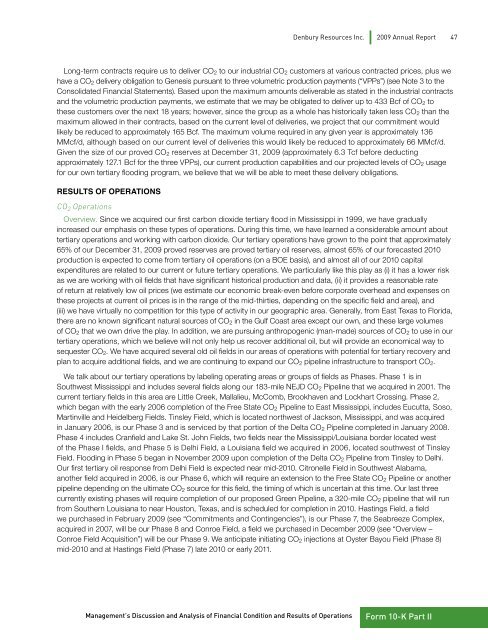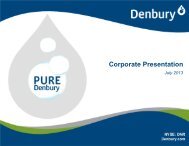Interactive 2009 Annual Report (PDF 7.56 MB) - Denbury Resources ...
Interactive 2009 Annual Report (PDF 7.56 MB) - Denbury Resources ...
Interactive 2009 Annual Report (PDF 7.56 MB) - Denbury Resources ...
- No tags were found...
Create successful ePaper yourself
Turn your PDF publications into a flip-book with our unique Google optimized e-Paper software.
<strong>Denbury</strong> <strong>Resources</strong> Inc. <strong>2009</strong> <strong>Annual</strong> <strong>Report</strong> 47Long-term contracts require us to deliver CO 2 to our industrial CO 2 customers at various contracted prices, plus wehave a CO 2 delivery obligation to Genesis pursuant to three volumetric production payments (“VPPs”) (see Note 3 to theConsolidated Financial Statements). Based upon the maximum amounts deliverable as stated in the industrial contractsand the volumetric production payments, we estimate that we may be obligated to deliver up to 433 Bcf of CO 2 tothese customers over the next 18 years; however, since the group as a whole has historically taken less CO 2 than themaximum allowed in their contracts, based on the current level of deliveries, we project that our commitment wouldlikely be reduced to approximately 165 Bcf. The maximum volume required in any given year is approximately 136MMcf/d, although based on our current level of deliveries this would likely be reduced to approximately 66 MMcf/d.Given the size of our proved CO 2 reserves at December 31, <strong>2009</strong> (approximately 6.3 Tcf before deductingapproximately 127.1 Bcf for the three VPPs), our current production capabilities and our projected levels of CO 2 usagefor our own tertiary flooding program, we believe that we will be able to meet these delivery obligations.Results of OperationsCO 2 OperationsOverview. Since we acquired our first carbon dioxide tertiary flood in Mississippi in 1999, we have graduallyincreased our emphasis on these types of operations. During this time, we have learned a considerable amount abouttertiary operations and working with carbon dioxide. Our tertiary operations have grown to the point that approximately65% of our December 31, <strong>2009</strong> proved reserves are proved tertiary oil reserves, almost 65% of our forecasted 2010production is expected to come from tertiary oil operations (on a BOE basis), and almost all of our 2010 capitalexpenditures are related to our current or future tertiary operations. We particularly like this play as (i) it has a lower riskas we are working with oil fields that have significant historical production and data, (ii) it provides a reasonable rateof return at relatively low oil prices (we estimate our economic break-even before corporate overhead and expenses onthese projects at current oil prices is in the range of the mid-thirties, depending on the specific field and area), and(iii) we have virtually no competition for this type of activity in our geographic area. Generally, from East Texas to Florida,there are no known significant natural sources of CO 2 in the Gulf Coast area except our own, and these large volumesof CO 2 that we own drive the play. In addition, we are pursuing anthropogenic (man-made) sources of CO 2 to use in ourtertiary operations, which we believe will not only help us recover additional oil, but will provide an economical way tosequester CO 2 . We have acquired several old oil fields in our areas of operations with potential for tertiary recovery andplan to acquire additional fields, and we are continuing to expand our CO 2 pipeline infrastructure to transport CO 2 .We talk about our tertiary operations by labeling operating areas or groups of fields as Phases. Phase 1 is inSouthwest Mississippi and includes several fields along our 183-mile NEJD CO 2 Pipeline that we acquired in 2001. Thecurrent tertiary fields in this area are Little Creek, Mallalieu, McComb, Brookhaven and Lockhart Crossing. Phase 2,which began with the early 2006 completion of the Free State CO 2 Pipeline to East Mississippi, includes Eucutta, Soso,Martinville and Heidelberg Fields. Tinsley Field, which is located northwest of Jackson, Mississippi, and was acquiredin January 2006, is our Phase 3 and is serviced by that portion of the Delta CO 2 Pipeline completed in January 2008.Phase 4 includes Cranfield and Lake St. John Fields, two fields near the Mississippi/Louisiana border located westof the Phase I fields, and Phase 5 is Delhi Field, a Louisiana field we acquired in 2006, located southwest of TinsleyField. Flooding in Phase 5 began in November <strong>2009</strong> upon completion of the Delta CO 2 Pipeline from Tinsley to Delhi.Our first tertiary oil response from Delhi Field is expected near mid-2010. Citronelle Field in Southwest Alabama,another field acquired in 2006, is our Phase 6, which will require an extension to the Free State CO 2 Pipeline or anotherpipeline depending on the ultimate CO 2 source for this field, the timing of which is uncertain at this time. Our last threecurrently existing phases will require completion of our proposed Green Pipeline, a 320-mile CO 2 pipeline that will runfrom Southern Louisiana to near Houston, Texas, and is scheduled for completion in 2010. Hastings Field, a fieldwe purchased in February <strong>2009</strong> (see “Commitments and Contingencies”), is our Phase 7, the Seabreeze Complex,acquired in 2007, will be our Phase 8 and Conroe Field, a field we purchased in December <strong>2009</strong> (see “Overview –Conroe Field Acquisition”) will be our Phase 9. We anticipate initiating CO 2 injections at Oyster Bayou Field (Phase 8)mid-2010 and at Hastings Field (Phase 7) late 2010 or early 2011.Management’s Discussion and Analysis of Financial Condition and Results of OperationsForm 10-K Part II




